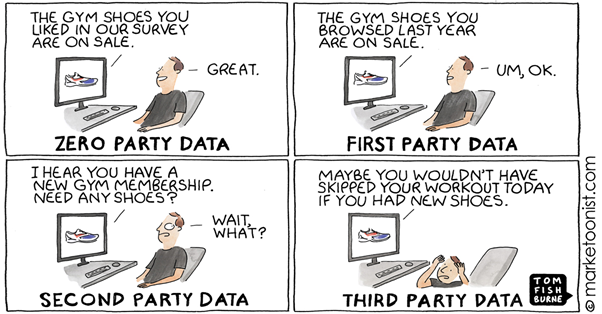Personalised cookies involve those giant Millie's ones with the name "DAVE" on it. Cookies without personalisation is a whole new kettle of fish.

A recent survey from McKinsey found that 90% of customers have concerns about online privacy, with half limiting their online usage because of these worries.
But on the other hand 64% of digital marketers say these concerns won't stop them from gathering all the data they need, in order to keep their ads as personalised as possible.
This is where the conflict comes in; consumers and marketers want to receive and give personalised ads, but everyone has concerns about data. But don't you worry, because we're going to figure this out together.
So, third-party cookies as a data source don't, and can't, cut it anymore. Instead, marketers need to focus on the relationships they can build using more trustworthy and transparent sources. Just like the ones we're going through today. You're welcome.
Plenty of industry changes are happening to prevent marketers from using third-party cookies, whether they want to move away from them or not. Web browsers like Firefox and Safari are going big on privacy consent, by blocking cookies and other data-gathering techniques.
And that's alongside Google Chrome, which will (eventually) disallow consumer tracking in this way. I mean, it's going to happen, even if they do keep pushing it back.
On top of this, Apple's iOS14 update introduced App Tracking Transparency, which makes it easier for consumers to opt-out from their data being shared and tracked across different apps. This means ad platforms like Facebook and Twitter will have reduced access to user information in this new space.
But we should probably go through the different types of data, and rate them for how invasive they are, right?

1. Zero Party data. This is when a customer willingly and proactively shares information with a company.
This might include product preferences, personal details and context, or how they want to be identified by the brand. It's all about asking, over inferring. A healthy relationship built on trust, hot chocolate, and apple pie.
Invasive Level: 0/5
2. First Party data. First party data is data collected directly from your own audience. This might be things like:
- Demographic
- Previously visited websites, and interactions
- Purchase history
- Personal interests
- Time spent on website
Basically, first-party data is collected from your own personal sources, and is often the most valuable. It's pretty easy to collect and manage, especially if you have a data management system. You can look at each other's phones to order pizza, with no arguments.
Invasive Level 1/5
3. Second party data. This is just first party data, but from a different source. You can look at his best friend's phone to order pizza, with no arguments.
Invasive level 2/5
4. Third party data. Third party data is data bought from data aggregator firms. These data aggregators collect data from a variety of websites and publishers. After collecting the data, the aggregator categorises it into handy categories, based on interests, characteristics, demographics, and more.
But remember, everyone has access to this data, so you'll lose any competitive edge. Everything you know about him is from second hand accounts from his Ex's, and his LinkedIn page. And his Ex's LinkedIn pages.
Invasive Level 5/5
What's the alternative?
Well, you might consider:
Number one: Using real-world events and moments
We can try to understand the consumer through their everyday life, the old fashioned way. Most of the time, digital ads only take into account what's happening in the digital environment, and not the 'real-world'.
So, instead, you could pair user level behavioural data with broader trends. This could be a weather moment like a snow day. A marketer might send an email round offering a 'snow day deal', or a home improvement brand might target consumers with anti-freeze or snow shovels.
Number two: IP-based Personalisation
Gareth Noonan, GM of Advertising at Demandbase, suggests this method. He says:
"IP-based identification will still allow personalization outside of the walled gardens of first-party cookies. Intent data, which can uncover which company is reading about a certain technology, can still be collected to power marketing and sales intelligence. IP-based identification will also still allow for personalized advertising creatives that attract and advertise relevant content."
Number Three: Zero Party Data
Zero party data is when a customer willingly and proactively shares information with a company. This might include product preferences, personal details and context, or how they want to be identified by the brand. It's all about asking, over inferring.
Forrester Research, who coined the term, describes it as:
"Zero-party data is that which a customer intentionally and proactively shares with a brand. It can include preference centre data, purchase intentions, personal context, and how the individual wants the brand to recognize [them]."
It's an equal exchange - zero party data is given freely, and in return the client gets their coveted personalised experience. In this way, it doesn't make sense to collect it for anonymous customers. Zero party data only makes sense for identified customers.
This form of data also tends to give companies a greater insight into customer needs, interests and intent, and explicitly rather than implied.
Consumers are becoming way more wary about the data collected about them, and how it's being used. Companies are being more cautious too. Legislation like the GDPR and CCPA are being enforced more strictly.
Recently, a lawsuit was brought against Oracle and Salesforce for their use of 3rd party tracking cookies which could end in fines in excess of €10B.
Digital Experience Platform
Steve Daheb, CMO at ON24 suggests that adding a digital experience platform to centralise your tech stack is the way to deliver personalisation without cookies. He says that:
"Digital experience platforms make it easy for enterprises to create, scale and personalize engaging webinar, virtual event and multimedia content experiences and garner rich, first-person data in the process."
User login-based identity
Through 'people-based marketing', brands can identify consumers across many different devices, platforms, apps, and channels based on their singular identity, revealed when they log in.
As it requires a customer to personally identify themselves, this technique requires consumer consent. Once consent is granted, brands are able to use the piece of personally identifiable information to track consumers on the sites they log into.
So, people-based marketing demands cooperation from a large number of sites in order to scale.

In simple terms, it's a case of keeping track of the person, not the device. a lot of money can be wasted on retargeting people who have already converted, just because they switched devices.
People-based marketing, introduced by Facebook Meta, relies on a unique identifier related to the user, not the device. It is 'a means to create a customer-centric, cohesive marketing system that revolves around customers and their real-time behavioural data. This data, combined with available first-party brand data, allows brands to target customers in real-time, across devices and channels," according to MartechSeries.
This all means that brands can meet customers at the right time and place, meaning that the relationship between business and customer is strengthened.
“I don’t think that behavioural marketing is going to go away, but we will have to shift to looking at the behaviour of known individuals,” said Jon Kagan, VP of search at Cogniscient Media.
AI and Disruptive Tech
Now for the sci-fi stuff. You can leverage AI and automation to make this whole transition a bit easier, by aiming to organise audience data and deliver precise personalised brand experience at all touchpoints.
ARA, the Machine Learning Engine utilised by the Quantcast platform, applies algorithms to data collected from 100M online destinations in real time. That data is then analysed using a set of predictive models that surface the behavioural patterns, which make it possible to target ad campaigns.
An alternative approach - 'ID resolution' - is based on AI. User identity can be determined by combining different bits of data about the user, and ML can create the user identity graph by piecing together all the data on hand.
Omni-channel identity resolution involves matching offline to online channels, as well as across devices. AI can integrate these channels to deliver omni-channel targeting by using anonymous identifiers.
Contextual Advertising
“The next best option to cookies based behavioural targeting is anything keyword or keyword contextual-based advertising," continues Jon Kagan.
"Years ago everyone discounted it and we moved further and further away from keyword targeting, but now we’re going to have to go straight back to it.”
Contextual advertising involves ads that are relevant to the other pieces of content on the screen. Think adverts for job sites on the tube. Or vodka on the tube. Or flight tickets to a deserted island on the tube. Go where the customers are.
These are far less invasive and creepy than cookie-based behavioural retargeting. Your purchase of BIG BILL'S ANTI-BOIL CREAM, EXTRA STRENGTH, MADE WITH CAR OIL, HORSE SHOES, AND PIG FAT. BIG BILLS. FOR BIG BOILS, PICK BIG BILL'S, might follow you round the internet, across recipe sites and online obituaries. Not ideal.
With contextual ads, the content you get is relevant to what your customer is looking at - if they're looking for knitting patterns, they'll get adverts for wool. This means they'll feel less invaded, and also be in the right place, at the right time.
Federated Learning of Cohorts (FLoC)
This is the most notable attempt by Google to offer a more private alternative that users and advertisers would be happy with.
The only problem is FLoC doesn't actually stop tracking completely. It instead put the tracking in Google's hands - funny that.
Chrome users' internet activity will be tracked through the browser itself, then Google will put users in large groups based on their interests. Advertisers then target the group, not the individual.
This is supposed to allow for a level of anonymity while still providing advertisers with the tools for personalisation. It doesn't hurt that the browser has much more control over the information collected this way, and advertising companies get much less.
Plus, it wasn't too popular with privacy experts, or regulators. In fact, the United Kingdom and European Union are investigating if it actually violates their antitrust laws.

